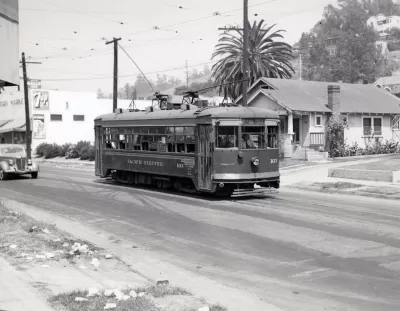Planopedia
Clear, accessible definitions for common urban planning terms.
What Are Streetcar Suburbs?
Named after the mode of transportation that made their existence possible by dramatically reducing travel times, streetcar suburbs are communities located along streetcar lines farther out from city centers, on the periphery of the urban areas in the late 19th century.

After electric streetcars were first introduced in 1887, they quickly exploded in popularity across the United States, replacing horse-drawn cars and making it possible to create extensive enclaves on urban peripheries, setting the stage for the mostly residential suburbs we see across the United States today. Streetcar suburbs were largely master-planned, highly controlled communities made up of small lots with quick access to local amenities and streetcar stations.
Despite their name, streetcar suburbs are often found within the boundaries of contemporary U.S. cities and make up a large part of urban development patterns. According to Living Places, "in cities of the Midwest and West, such as Indianapolis and Des Moines, streetcar lines formed the skeleton of the emerging metropolis and influenced the initial pattern of suburban development." The low fares and free transfers offered by streetcar operators attracted people from different economic classes and encouraged more families to seek housing on the periphery of cities. "Unlike railroad suburbs which grew in nodes around rail stations, streetcar suburbs formed continuous corridors. Because the streetcar made numerous stops spaced at short intervals, developers platted rectilinear subdivisions where homes, generally on small lots, were built within a five- or 10-minute walk of the streetcar line." Some of the earliest streetcar suburbs include Cleveland's Shaker Heights, L.A.'s Angelino Heights and West Hollywood, and Atlanta's Inman Park.
In some cases, streetcar operators and housing developers were one and the same. As John Perry reminds us, "[r]eal estate development has always been the raison d’être for most streetcar lines." In fact, "[a]ll of the neighborhoods immediately surrounding Downtown Los Angeles were originally built as streetcar suburbs, as well as quite a few neighborhoods further beyond." These lines were eventually consolidated into the Pacific Electric and the Los Angeles Railway, the competing companies owned by real estate magnates Henry Huntington and Isaias Hellman.
Rise of the Automobile
After reaching peak ridership in 1923, streetcar use slowly declined as roads became clogged by personal vehicles and automobiles became increasingly affordable to more people. Contrary to the conspiracy narrative popularized by the film Who Framed Roger Rabbit?, by the time National City Lines–a holding company backed by GM, Firestone Tire, and Standard Oil–started buying up streetcar lines in 1938, their operators were already facing dire financial circumstances thanks to rising urban traffic and low revenues. According to Stephen Smith, "eager to receive guarantees on their large up-front investments, streetcar operators agreed to contract provisions that held fares constant at five cents and mandated that rail line owners maintain the pavement around their tracks." But as private cars started taking up more of the road–including, in most cities, streetcar tracks themselves–streetcars couldn't continue providing reliable service. "In some places, like Chicago, streetcars retained dedicated rights of way, and they survived. Pretty much anywhere else, they were doomed." By the 1950s, with most streetcar companies facing bankruptcy and the national highway system making it easier and more affordable than ever to get around by automobile, streetcar systems around the country were largely decommissioned in favor of cheaper, more flexible buses and private cars.
How Streetcar Suburbs Still Shape Urban Form
Due to their unique location and design, many of the communities born as streetcar suburbs remain vibrant communities today. As Peter Saunders argues in his blog, streetcar suburbs benefit from being "fully functional long after the streetcar line tracks have been pulled up." In an essay by Leah Brooks and Byron Lutz, the authors argue that Los Angeles, which saw its last streetcar lines removed in 1963, is still profoundly shaped by the now-defunct streetcars that dominated the city's transportation landscape in the early 20th century. Their research found that L.A. "[l]ocations less than half a kilometer from the extinct streetcar are more than twice as population-dense as locations two kilometers from the extinct streetcar." Brooks and Lutz attribute the continued influence of streetcar lines on urban density largely to two key factors: "land use regulation and the self-reinforcing economic benefits of density." Former streetcar suburbs in Denver, San Francisco, and Seattle still guide development patterns despite the car-oriented planning that dominated the latter part of the 20th century.



























